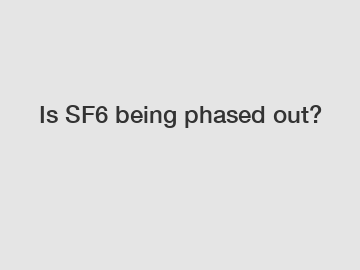Is SF6 being phased out?
Sulfur hexafluoride, or SF6, has long been used as a highly effective insulating and arc-quenching gas in high-voltage electrical equipment. However, concerns about its impact on the environment have led to calls for its phase-out. But is SF6 really being phased out, and what are the alternatives?
Let's start by looking at why SF6 has been such a popular choice for use in electrical equipment. One of the main reasons is its excellent insulating properties. SF6 is a highly electronegative gas, which means it has a high capacity to absorb free electrons. This makes it an effective insulator, as it prevents the free flow of electrons in electrical systems.
SF6 is also extremely effective at extinguishing arcs. When a fault occurs in an electrical system, an arc is generated as the current jumps between two conductors. SF6 quickly absorbs the energy from the arc, extinguishing it before it causes damage to the equipment. This has made SF6 the go-to choice for high-voltage systems for many years.

However, SF6 is also a potent greenhouse gas, with a global warming potential (GWP) of 23,500 over a 100-year time horizon. This means that one ton of SF6 emissions is equivalent to 23,500 tons of CO2 emissions in terms of its impact on the climate. Given the urgent need to reduce greenhouse gas emissions and combat climate change, the use of SF6 has come under increasing scrutiny.
In response to these concerns, a number of countries and organizations have taken steps to phase out the use of SF6 in high-voltage electrical equipment. The European Union, for example, has set a target to reduce the use of SF6 in electrical switchgear by 80% by 2030. Switzerland has also announced plans to end the use of SF6 in medium-voltage switchgear by 2025.
So, what are the alternatives to SF6? One option is to use gases with lower GWP, such as nitrogen or CO2, as insulating and arc-quenching mediums. These gases are less harmful to the environment than SF6 and have been shown to be effective in electrical systems. However, they may not have the same insulation and arc-quenching properties as SF6, so further research and development are needed to ensure their viability as alternatives.
Another option is to use solid-state or vacuum interrupters in place of gas-insulated switchgear. Solid-state devices, such as semiconductors, offer a more compact and efficient solution for electrical switching, with no greenhouse gas emissions. Vacuum interrupters, on the other hand, use a vacuum to extinguish arcs, offering a clean and environmentally friendly alternative to SF6.
It's clear that the phase-out of SF6 is a complex issue that requires a careful balance between the need for reliable and efficient electrical equipment and the need to protect the environment. While progress is being made in reducing the use of SF6 in high-voltage systems, more work needs to be done to develop and deploy viable alternatives.
As experts in the field of high-voltage electrical systems, we understand the challenges and opportunities presented by the phase-out of SF6. We are committed to finding innovative solutions that meet the needs of our customers while also protecting the environment. Our team of engineers and researchers are constantly exploring new technologies and materials to improve the efficiency and sustainability of electrical systems.
In conclusion, the phase-out of SF6 is an important and necessary step towards reducing greenhouse gas emissions and combating climate change. While the transition to alternative technologies may pose challenges, it also presents exciting opportunities for innovation and progress in the field of electrical engineering. As we continue to work towards a more sustainable future, we remain dedicated to finding solutions that benefit both our customers and the planet.
Contact us to discuss your requirements of refrigerant gas supplier, boron trifluoride gas, Ch4 Gas for Sale. Our experienced sales team can help you identify the options that best suit your needs.
200
0
0

Comments
All Comments (0)